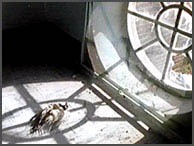
Handcranked Madness
Written by Simon Rucker | Posted by: Anonymous
Bryan Papciak’s animated short film "Met State" was an official selection of the Sundance Film Festival 2003 and has received numerous festival awards for Best Experimental Film. "Met State" is a 10-minute visual portrait of an abandoned insane asylum, filmed over two years in different conditions and employing different film and animation techniques. Papciak is also one of the founding members of Handcranked Film Projects, a Boston-based filmmakers’ collaborative exploring the arts through non-commercial, experimental media.
SR: How did you come up with the idea for the film?
Papciak: I’ve always been into interesting looking places, especially abandoned buildings. The film evolved out of that interest. It wasn’t just that place I’ve been, others too.
SR: Where was the film made?
Papciak: It’s the old Metropolitan State Hospital in Waltham. They’re everywhere — Bridgewater, Northampton, Danvers, Foxboro. All of them were closed around the same time, from the mid 1980’s to the early 1990’s, and they’re all in pretty much the same condition and have similar architecture. I enjoy photographing these kinds of places and over time enough footage emerged to make a film. Originally I went because I was kind of obsessed with the place, but the film came out of it when I just kept going and shooting and shooting, and the more footage I had the more I wanted to make a film about that place and not about random architecture and abandonment.
SR: What techniques did you use to make the film?
Papciak: It was all shot with a 16mm Bolex and the main technique used is called pixilation, where you move the camera instead of objects in front of the camera. We would shoot a single frame and then move another 6 to 8 paces and take another frame, and over a period of time it creates that motion of velocity and propulsion through the place. It’s so huge and overwhelming that there’s no way to capture the feel of it, but pixilation was one way of giving a kind of high velocity tour. All the film was mysterious to me until I decided to use the pixilation as a way to map it and understand it, and I think it gives a skewed perspective that’s particularly pertinent in a mental institution.
Other techniques included optical printing, where the film itself would be printed through a variety of color filters to produce high contrast and graininess, and also found object stop motion animation. The difficulty with that technique is to keep real time in mind, so that we had to wait for the weather to behave and make sure the sun didn’t skip around. There aren’t that many of those shots because they’re so difficult to do.
SR: How important is the music, "Danse Macabre" by Saint-Saens, to the film?
Papciak: The music is very interesting to me because when putting all this stuff together as a film I wasn’t considering the idea of a score at all, but I love the idea of a danse macabre. With the introduction of pixilation the film became much more intense and high speed. I had coincidentally picked up the music at Tower Records, I liked the story of it and the cover, and I thought I might try it out with the film. I was astounded when it more or less synched up to the already edited film. There were some small differences but it worked well enough and it turned the film into something very different, so I re-edited. I was shocked at how well it lined up, I took it as a sign from beyond. Oddly enough after one of the screenings for the film somebody who had worked there told me that the same music had been played a lot for the patients. It really creeped me out — why would you play that for somebody who was already mentally disturbed? It’s this hurtling dance of death.
SR: How did you get started in film and animation?
Papciak: I had a background in live action but I did a short animated film and started getting jobs because of that. Almost all the jobs I got were in animation and eventually I found myself at Olive Jar studios in Boston. It was a really great community of animators and artists and from there I branched out into commercial animation work and film work. From that work I started with Handcranked Film Projects, which co-existed with Olive Jar and consisted of myself, Daniel Sousa, Jeff Sias and Jake Mahaffy. That group still exists but Olive Jar closed. We’re all working on things independently but keep the artistic group together to make short films.
SR: How does your commercial film connect with your artistic work?
Papciak: Personally I try to keep them separate. "Met State" was a response to the way animation is done commercially. In a commercial, where time is so limited everything is so hyper-controlled and a personal film, to me, is about no constraints — using the same techniques but not confining them to a particular storyboard or the 30-second format.
SR: What kind of projects are you working on now?
Papciak: With one of the other Handcranked guys, Jeff Sias, who’s also my commercial partner right now, he and I are working on a project called "American Ruins," which capitalizes on both our common interest in abandoned places. We’re taking road trips all over the country, doing little vignettes about interesting places. It’s, bizarrely, one of my favorite things to do. This is project is going to go on for a while. My other floating project is a live action animated film about an Italian saint from the 1600s.
'Met State' will screen on May 3 at 10 pm at the Somerville Theater as part of the first annual Boston Independent Film Festival. Watch 'Met State' online as part of the Sundance 2003 Online Film Festival at www.sundanceonlinefilmfestival.org/shorts01_03.html. More information about 'Met State' and Bryan Papciak is at www.handcrankedfilm.com.









